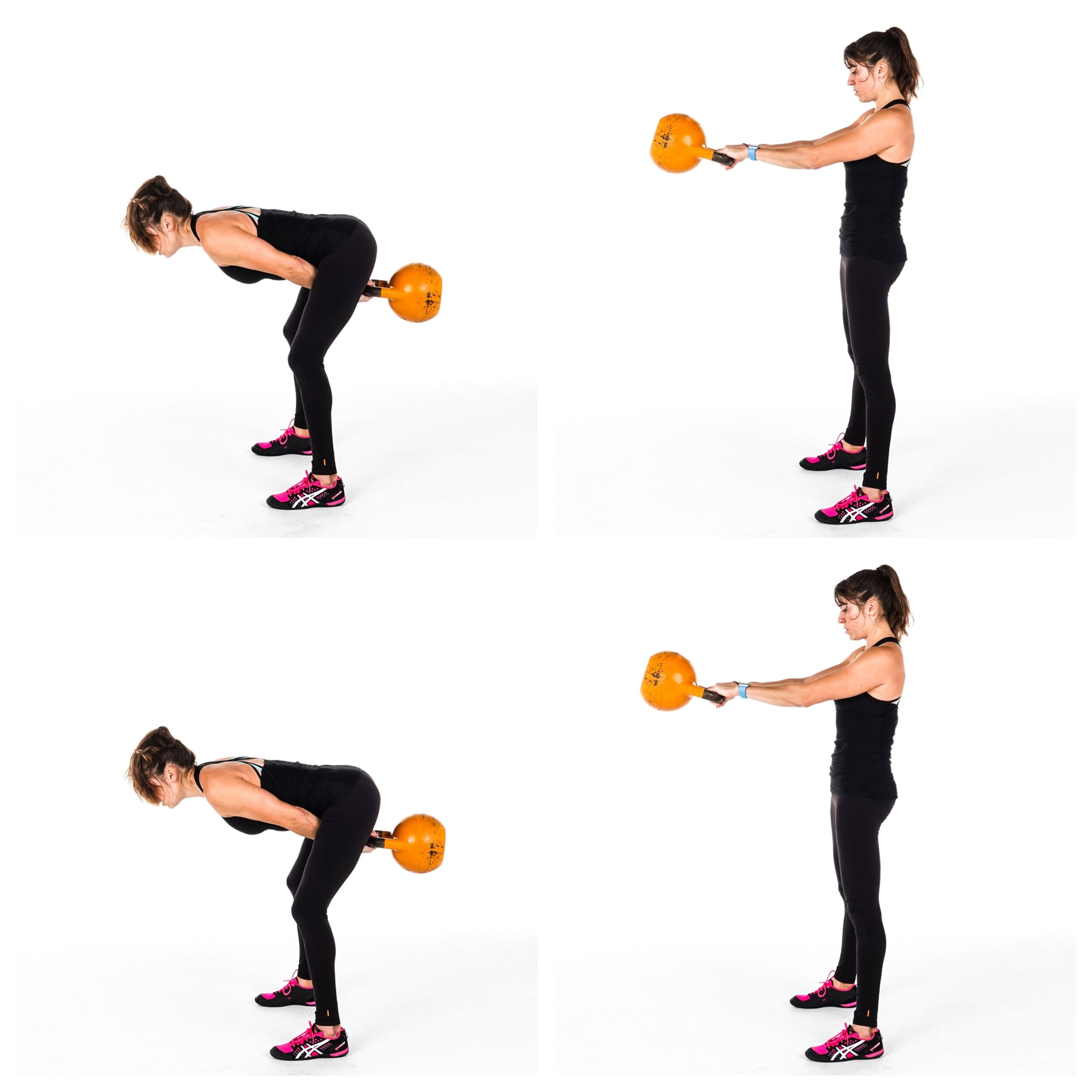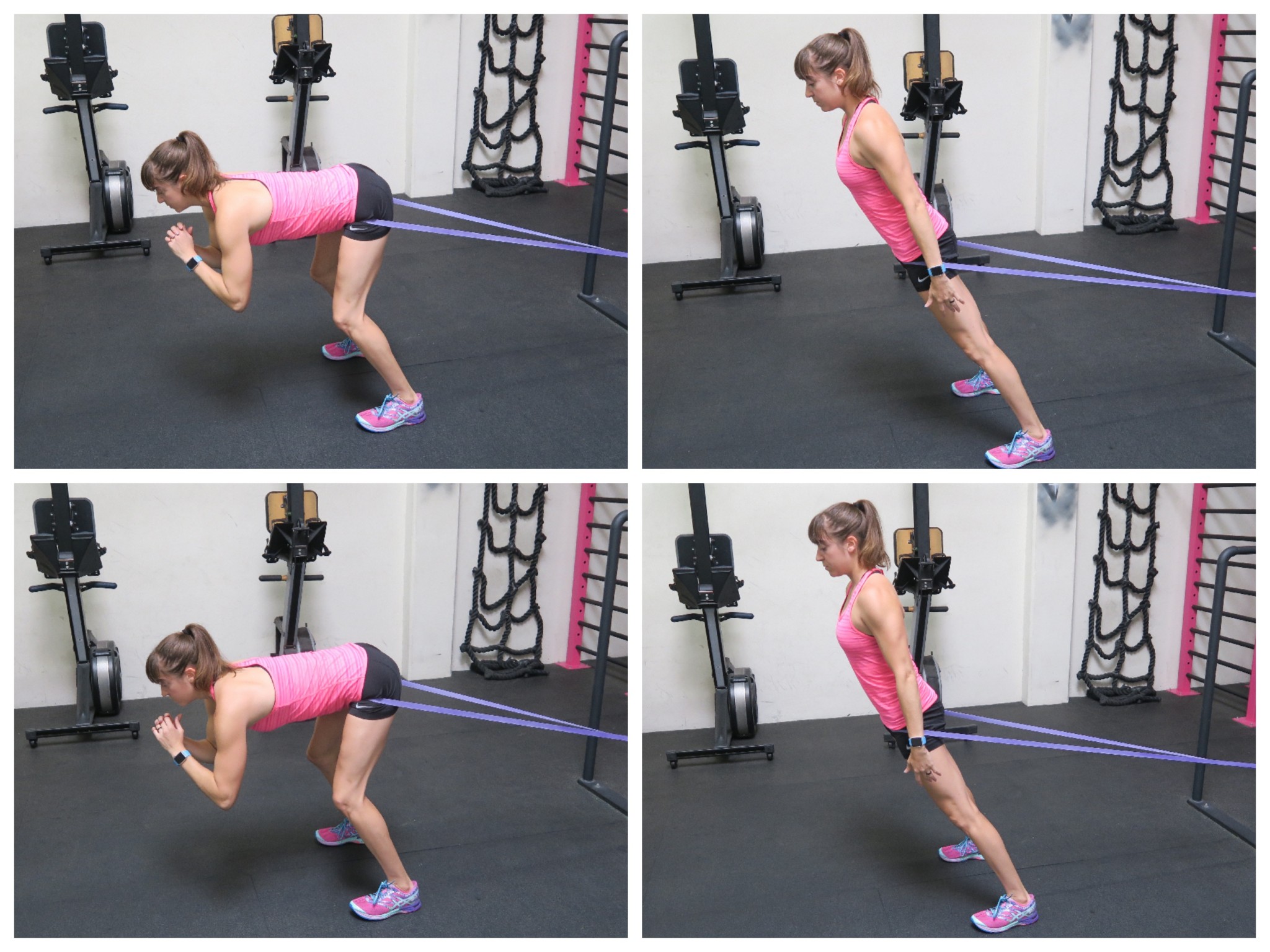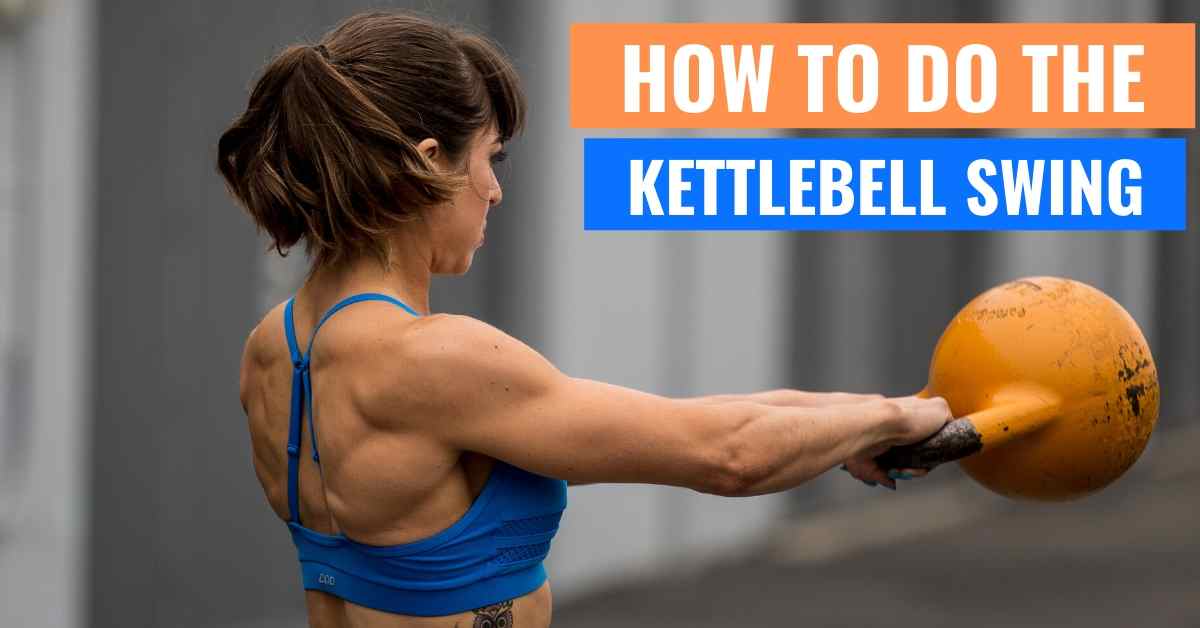The Kettlebell Swing is taught a variety of ways, but there are two main “variations” – the Russian swing and the American swing.
I personally only ever use the Russian style, hip hinge swing ending no higher than chest height. So below I’m going to go over form for that hip hinge movement instead of the American style overhead swing.
The Kettlebell Swing can be a great glute exercise to help you improve your power and your strength. It can also be a great conditioning exercise that is lower impact.
And of course, it also is great to build grip strength!
It is even thought by many to be one of the best, if not the best, explosive glute exercise!
Below learn how to do the basic Kettlebell Swing as well as some fun variations!
And if you’d like to learn more about Kettlebell training in general, scroll to the end of the post to watch my Science Behind Kettlebells Training Video!
How To Do The Kettlebell Swing:

So there are thought to be two main coaching techniques for the Russian style swing – hardstyle and kettlebell sport.
You will tend to see just a tad more knee bend with the hardstyle swing as well as less hinge forward while the kettlebell sport you may see slightly straighter legs on the full hinge and slightly more lean forward.
Based on your build, you may find your form ends up being a hybrid. And that’s ok.
You want to focus on that hinge and loading that posterior chain while engaging your lats to prevent round or lumbar loading.
Also do not arch your lower back just to keep your chest up.
With both moves the key is in the hip hinge aka pushing the butt back to load those glutes!
To do the hip hinge kettlebell swing, set the kettlebell down on the ground and slightly in front of you between your feet.
Hinge over, bending your knees slightly and pushing your butt back as you lean forward. Keep your back flat and then reach your arms out and place both hands on the handle, tilting the kettlebell back toward you.
Hike the kettlebell back between your legs like you would a football. Pull it back and up between your legs toward your butt.
To power the kettlebell up and forward out in front of you, drive your hips forward and stand up tall. Think about driving the ground away to stand up tall as you squeeze your glutes. Pop your hips forward and propel the kettlebell up off your hips.
Do not worry about how high the bell goes. It shouldn’t go higher than your shoulders.
Squeeze your glutes as you stand tall. You do not want to arch your low back at the top. Also fight really leaning back in an attempt to pull the kettlebell higher.
Then, keep your glutes tight, wait as the kettlebell comes back down before you hinge back over. Your forearms need to connect with your hips before you hinge back over and bring the kettlebell back down and through your legs.
Do not lean forward and hinge over before the kettlebell comes back down. You want to hinge in response to the weight and load your glutes as you hinge back over with soft knees.
As your forearms connect and you hinge over, sit your butt back. Let the kettlebell reach through toward the wall behind you. If the kettlebell comes up and taps you in the butt, it may be too light.
Then squeeze your glutes again and thrust the kettlebell back up as you come back up to standing.
With the swing, bend your knees a little as you hinge back over. With kettlebell sport swings, you may slightly straighten your legs at the back of the swing. With hardstyle, you will keep your knees soft in the hinge and straighten as you stand up. They are both acceptable just different styles. Find what works for your mobility and build so that you aren’t loading your lower back.
Make sure to squeeze your glutes at the top of each swing and make sure you don’t come up onto your toes. You want your foot to be firmly planted.
Maintaining the connection between your forearms and hips as you hinge is essential for keeping your glutes working and your low back from feeling strained. Do not sit your butt back while the kettlebell is still out in front of you. You almost want the kettlebell to be the reason why you are hinging over.
The hinge is a reaction to the bell instead of you anticipating the kettlebell coming back down and hinging over before it lowers.
Start small with the swing to focus on the connection. You don’t have to get the kettlebell all the way up to your chest to get a lot out of the movement.
Kettlebell Swing Variations:
The basic Kettlebell Swing is done holding a single bell with both hands; however, you can also do a Single Arm Swing or even two different Double Kettlebell Swing variations.
To do the Single Arm Kettlebell Swing, you will place the kettlebell a little out in front of you, but instead of grabbing it with both hands to hike it back, you will grab it with only one.
Below I show alternating hands BUT you can stay on one side to complete all reps too!
You can grab the kettlebell to swing so that your thumb is pointing back through your legs or out in front of you. Either works just pick whichever is most comfortable.
Just like with the basic swing, power the move with your glutes and hinge at the hips. Focus on that connection between your forearm and your hips as you swing the bell.
However, unlike the basic swing, you may rotate a bit with the single kettlebell as you reach the kettlebell back through your legs. It can also feel best, with the single arm swing, to follow the kettlebell with your other arm.
Just like with the basic swing it doesn’t matter how high up you swing the kettlebell. Focus on the connection between your forearm and hip and powering the movement with your glutes. This can be a great swing variation to help you work toward the full kettlebell clean.
Remember the swing is a HIP HINGE movement NOT A SQUAT.
To do the Double Kettlebell Swing variations, you will either swing both bells between your legs or outside your legs. Outside your legs is called the Skier Swing.
If you swing the kettlebells between your legs, the swing is basically the same as with the Basic Kettlebell Swing except you will be holding a kettlebell in each hand. Focus on hinging at the hips as the kettlebell goes back and powering the move with your glutes. The connection between your arms and hips is even more important, especially if you are using more weight!
If you swing the kettlebells outside your legs, the movement will look almost like skiing. You will stand with your feet closer than hip-width apart.
Hinge over and reach to grab the kettlebells. There will only be a slight bend in your knees. Then hike the kettlebells up and outside your hips.
You will lean forward as you push your butt back to swing the kettlebells up outside your hips.
Then squeeze your glutes and come up to standing as you swing the kettlebells up. You may lean back a little as you squeeze your glutes to counterbalance the weight of the kettlebells. Do not lean back too much though and load your low back. You aren’t arching back, just squeezing your glutes and full extend your hips.
Be patient and wait for the kettlebells to come back down and force you to hinge back over and sit your butt back. Do not sit back before the kettlebells come back down. Even though you don’t have the hip/forearm connection to guide you, you need to wait for the kettlebells to swing back down or you will lose your balance.
As you sit back, you will lean forward, hinging at the hips to counterbalance.
Make sure with all of these swing variations that you do not feel the move in your low back or turn them into a squat.
Also, remember that it doesn’t matter how high you swing the kettlebell up. The most important thing is that you hinge at the hips and power the movement with your glutes!
Do not progress to a single arm or even double kettlebell swing if you haven’t master the basic movement. Also, you may find it easier to learn the movement with a slightly heavier kettlebell than you think you should use. If you go too light, you will be tempted to use your arms to lift the kettlebell. A heavier weight forces you to use your glutes.
Beginners struggling with the movement may even want to start with a Band Hip Hinge.
The Band Hip Hinge will teach them the basic swing hip hinge movement and help them learn how to use their glutes to power the move.
It’s also a great way to include some explosive hinge hinge work if someone has an upper body injury OR struggles with really activating their glutes!





I keep hearing that you shouldn’t be squatting during a Kettlebell swing. What would you suggest for people like me with balance problems, who sort of have to squat a bit to stay balanced while swinging? My feet seem to fall right out from under me if my knees aren’t bent into a squat.
Hi Katie…So The kettlebell swing is a hip hinge exercise not a squat which means you want to think about hinging at your hips and using your glutes to power the move. That doesn’t mean you can’t bend your knees. Your knees should be soft and depending on your mobility, you may have your knees a bit more bent. You just don’t want to actively be bending your knees instead of hinging at the hips. Also, you may find you are losing balance because the connection between your forearms and hips is off as you swing, causing you to lose your balance.
If you would like me to review your form, you can send me a video at [email protected]. Hope this helps! Cori
Muchas gracias por la información.
Saludos desde Costa Rica
Glad it helps!